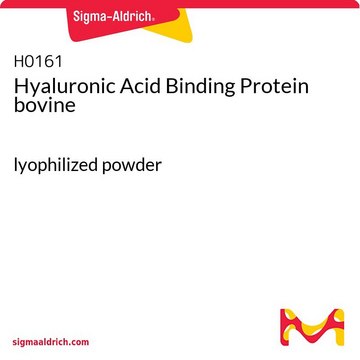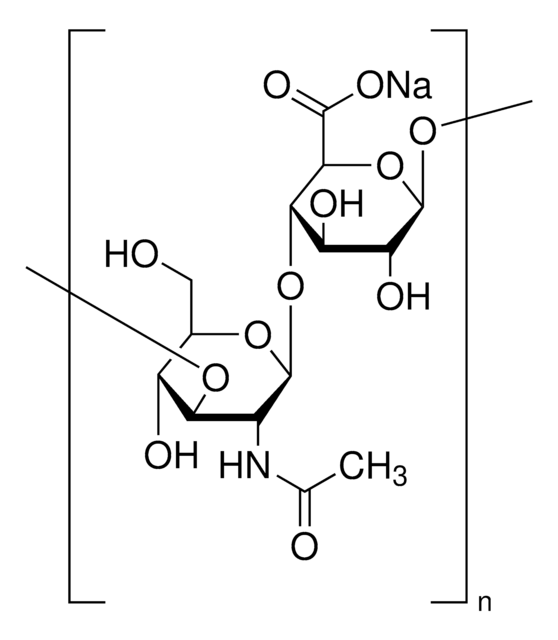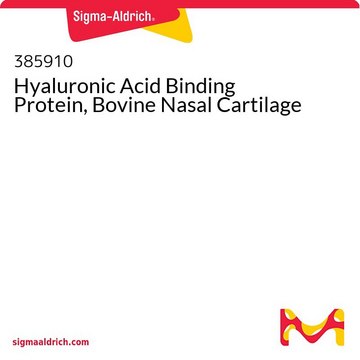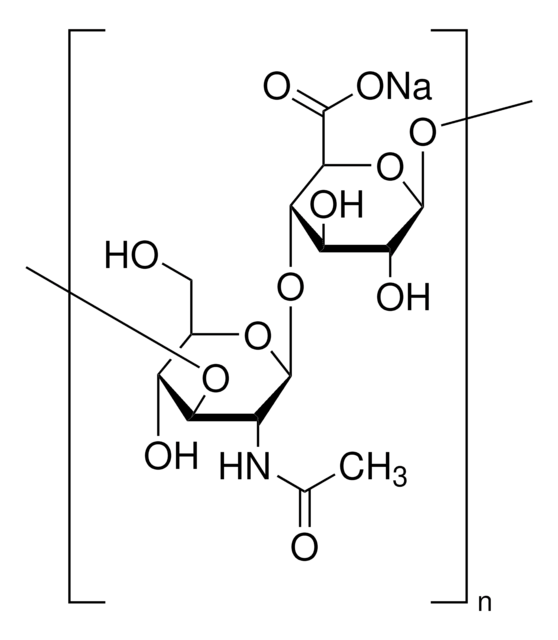H9910
Hyaluronic Acid Binding Protein−Biotin bovine
lyophilized powder
Sinônimo(s):
HABP-Biotin
Faça loginpara ver os preços organizacionais e de contrato
About This Item
Produtos recomendados
forma
lyophilized powder
Nível de qualidade
nº de adesão UniProt
temperatura de armazenamento
−20°C
Informações sobre genes
cow ... VCAN(282662)
Aplicação
Hyaluronic acid binding protein-Biotin bovine has been used in the immunohistochemistry of human bone marrow samples for the detection of hyaluronic acid. It has been used for the detection of hyaluronan in Xenopus tadpoles.
Ações bioquímicas/fisiológicas
May be useful for hyaluronic acid detection.
forma física
Contains 1% bovine serum albumin, 0.85% NaCl, and 0.125% sodium phosphate.
Nota de análise
multiple bands on SDS-PAGE
Código de classe de armazenamento
11 - Combustible Solids
Classe de risco de água (WGK)
WGK 2
Ponto de fulgor (°F)
Not applicable
Ponto de fulgor (°C)
Not applicable
Certificados de análise (COA)
Busque Certificados de análise (COA) digitando o Número do Lote do produto. Os números de lote e remessa podem ser encontrados no rótulo de um produto após a palavra “Lot” ou “Batch”.
Já possui este produto?
Encontre a documentação dos produtos que você adquiriu recentemente na biblioteca de documentos.
Os clientes também visualizaram
Esteban G Contreras et al.
Development (Cambridge, England), 136(17), 2987-2996 (2009-08-12)
Tail regeneration in Xenopus tadpoles is a favorable model system to understand the molecular and cellular basis of tissue regeneration. Although turnover of the extracellular matrix (ECM) is a key event during tissue injury and repair, no functional studies to
Chung-Hao Lu et al.
PloS one, 8(8), e74602-e74602 (2013-09-12)
The serpin peptidase inhibitor, clade E, member 2 (SERPINE2) inhibits urokinase-type plasminogen activator (PLAU) and tissue-type plasminogen activator. Higher SERPINE2 expression levels were detected in cumulus cells of human immature oocytes than in those of mature oocytes. The objective of
J Melrose et al.
Electrophoresis, 17(1), 205-212 (1996-01-01)
Hyaluronan influences cellular proliferation and migration in developing, regenerating and remodelling tissues and in tissues undergoing malignant tumour-cell invasion. The widespread occurrence of hyaluronan-binding proteins indicates that the recognition of hyaluronan is important to tissue organisation and the control of
Abraham Avigdor et al.
Blood, 103(8), 2981-2989 (2004-04-09)
Trafficking of human CD34+ stem/progenitor cells (HSCs/HPCs) is regulated by chemokines, cytokines, proteolytic enzymes, and adhesion molecules. We report that the adhesion receptor CD44 and its major ligand, hyaluronic acid (HA), are essential for homing into the bone marrow (BM)
G Perides et al.
The Journal of biological chemistry, 264(10), 5981-5987 (1989-04-05)
A glial hyaluronate-binding protein (GHAP) with an isoelectric point of 4.3-4.4 was isolated from human brain white matter. The 60-kDa glycoprotein appeared to be quite resistant to proteolysis, and comparison with GHAP from a viable glioma removed at surgery showed
Nossa equipe de cientistas tem experiência em todas as áreas de pesquisa, incluindo Life Sciences, ciência de materiais, síntese química, cromatografia, química analítica e muitas outras.
Entre em contato com a assistência técnica







